As the “King of the Beasts” or “King of the Jungle,” lions command a universal symbol of strength and courage. They proudly rank as the second-largest big cat species in the world, trailing only tigers. Typically, an adult male lion tips the scale between 330 to 550 pounds. Generally smaller, females weigh between 265 to 400 pounds.
From head to tail, males stretch out to a length of 5 to 7 feet, while females reach a length of 4.5 to 6 feet. Adding to their grandeur is their tail, a distinctive feature among big cats, thanks to their tassel at the end. This tail contributes an extra 2 to 3 feet to their length.
These numbers give us the average sizes, but history presents us with remarkable outliers. Some have defied these averages, showcasing staggering weights and lengths.
In this article, we discover the largest lion ever recorded. We will journey through the big cat’s world and explore not only this mammoth lion’s story but also delve into why it grew so large. In addition, we’ll discuss their natural habitat, diet, unique behavior, and even the challenges and threats these awe-inspiring animals face in today’s world.
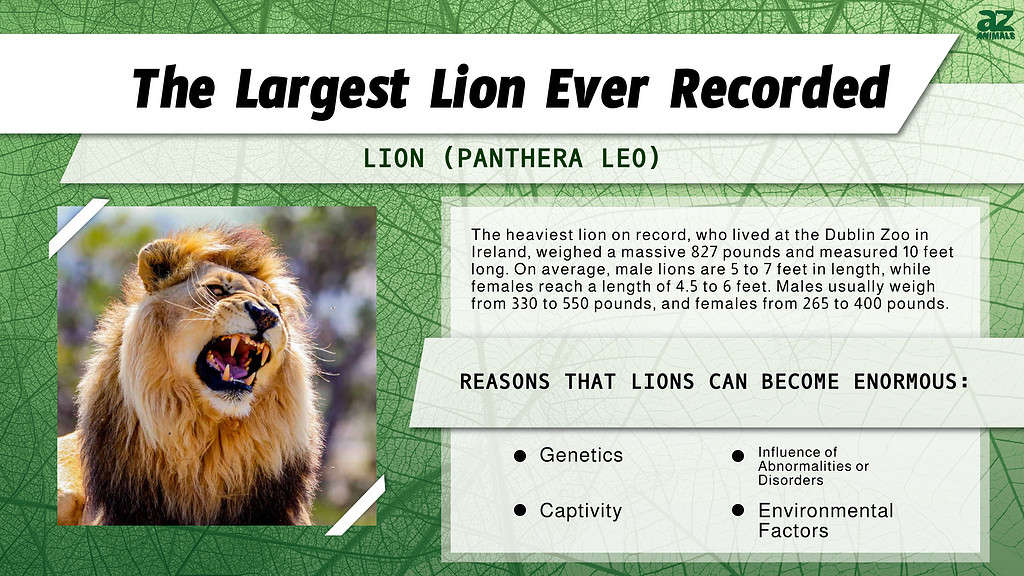
The Largest Lion Ever Recorded
Ever thought about how much a lion weighs? Well, let’s take a journey into the realm of the big cats, where we’ll meet the heaviest one ever recorded. The size of this creature is mind-boggling!
The Heaviest of Them All
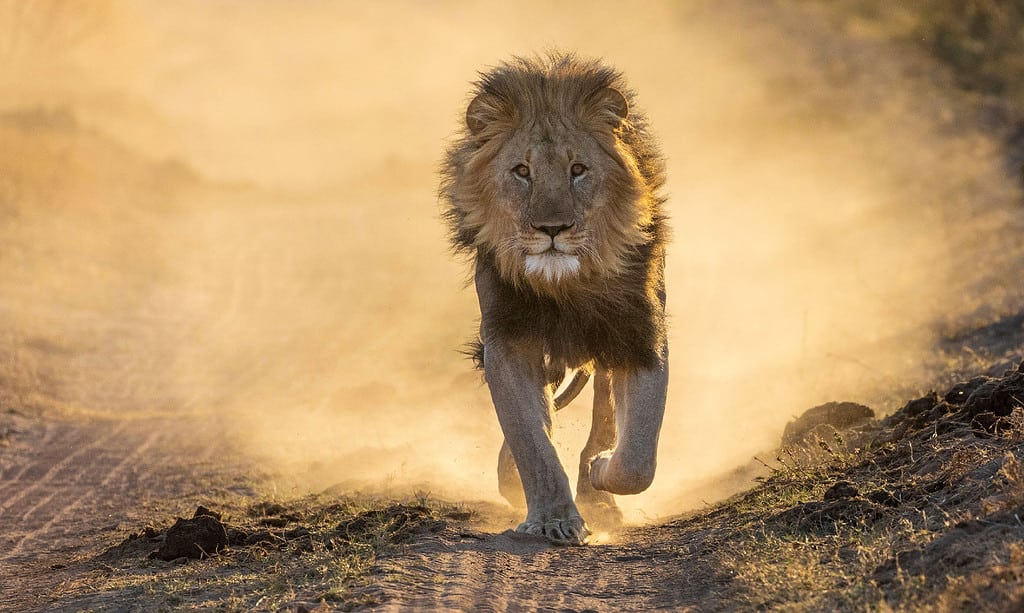
Males weigh between 330 to 570 pounds when fully grown, but some individuals exceed 600 pounds!
©iStock.com/Wirestock
Our record-holder lived his life in Dublin Zoo, Ireland, back in 1959. He was not your ordinary lion. Weighing in at a whopping 827 pounds, he was more massive than the average grizzly bear. Just imagine a lion heavier than a bear. His weight is the equivalent of around seven average-sized men!
This Dublin Zoo resident was not just notable for his weight but also his size. This king of beasts measured over 10 feet long, about the length of a small car.
Challenging the Throne
In the realm of the big cats, new contenders are emerging. There have been recent reports of lions reaching, or even exceeding, our Dublin giant’s size. A certain YouTube video showcases two such big cats, whose owner claims to weigh between 900 to 1000 pounds. These big cats would make even our heavyweight champ look lean.
However, the legitimacy of these claims hinges on a crucial detail: both of these enormous animals were castrated at birth. This uncommon procedure, paired with life in captivity, might have played a part in their immense size.
The reports of these larger beasts have stirred debates. Are they legitimate record-breakers? Could they dethrone the one from the Dublin Zoo from his spot as the heaviest ever recorded? These questions remain a matter of discussion among wildlife experts and enthusiasts.
3 Reasons It Grew So Big
Let’s dive a little deeper into the story of our record-breaking lion. Why did he grow so large? This journey takes us through the fascinating world of genetics, biological conditions, the influence of captivity, and even the role of unique procedures like castration.
Reason #1: Genetics
In the world of biology, genetics is like a roll of the dice. Each creature inherits a unique combination of genes from its parents that determines various traits, including size. Some lions, like our Dublin Zoo resident, hit the genetic jackpot, inheriting a set of genes that led to an extraordinary size. While we can’t say for certain without genetic testing, the beast’s immense size may well be the result of a fortunate alignment of growth-promoting genes.
Reason #2: The Influence of Abnormalities or Disorders
In the natural world, abnormalities and disorders can sometimes lead to outsized growth. This process is akin to a software glitch that causes a system to behave unusually. Some sources speculate that our heavyweight champion may have had a disorder that contributed to his weight gain, causing him to pile on the pounds in a way that is atypical for his species.
Reason #3: Captivity

Lions in captivity are fed daily rather than having to hunt for their food.
©iStock.com/Hlnlvns
Our record-breaker spent his life in the Dublin Zoo, which might have been a crucial factor in his massive size. Lions in captivity enjoy a constant supply of food, unlike their wild counterparts, who must hunt for each meal. This steady access to nutrition likely fueled his growth. But captivity has its downsides, too, such as limited space for exercise. This lack of activity could have led to unhealthy weight gain, contributing to his extraordinary size.
Other Large Lions Ever Recorded
You’ve heard all about our colossal lion from Dublin Zoo, but he’s not the only sizeable cat to have graced this planet. Let’s have a look at some other notably large lions ever recorded.
The Transvaal Lion of 1936
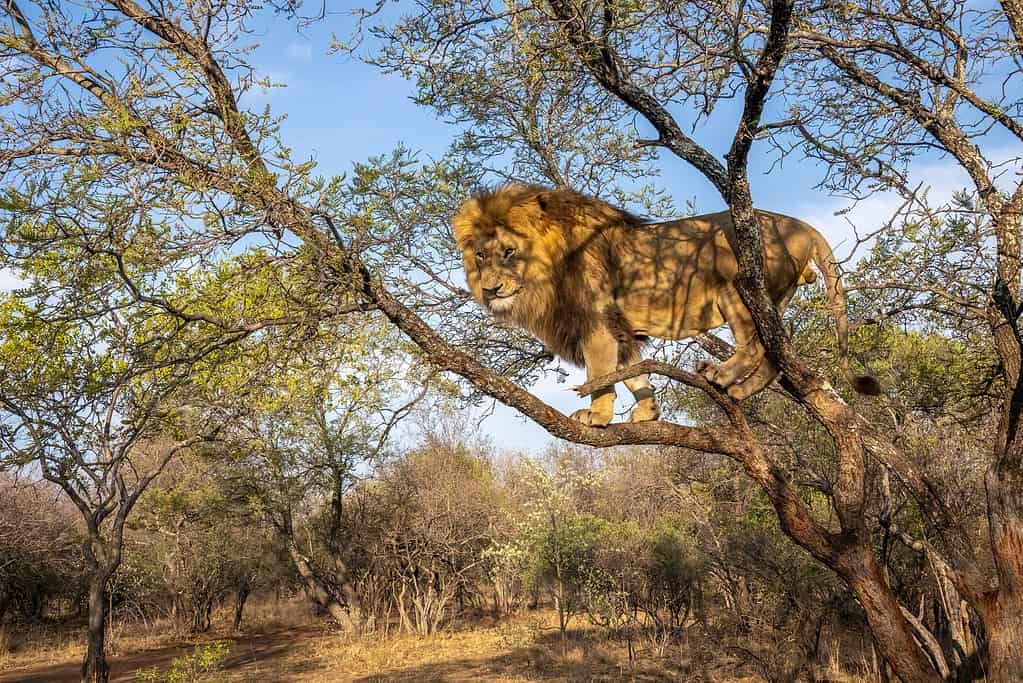
The Dublin Zoo lion is not the only one to ever reach such an impressive size.
©Evelyn D. Harrison/Shutterstock.com
First up, we take you back to 1936 in South Africa‘s Transvaal area. A male lion was shot that year weighing an impressive 690 Pounds. Unfortunately, this particular lion was not only massive but had taken a dark turn, preying on humans in the local area. In response to this threat, big cat hunter Lennox Anderson eliminated the lion, leading to its recorded weight.
Mufasa of Montana
Then there’s Mufasa, a male lion living in an animal sanctuary in Montana, USA. In 2014, Mufasa weighed around 635 pounds, making him one of the biggest lions of recent times.
Hercules the Liger

The liger, a cross between a male lion and a female tiger, is the strongest hybrid cat.
©iStock.com/yod67
Hercules the Liger, although not a pure lion, cannot be overlooked as he made two appearances in the Guinness Book of World Records in 2006 and 2013. A liger is a hybrid offspring of a male lion and a female tiger, and Hercules was enormous, weighing over 900 pounds.
Where Do Lions Live?
Let’s take a trip to the homelands of these big cats, from the vast expanses of Africa to the Gir Forest of India. They have adapted to a variety of habitats, but where exactly do these majestic creatures call home?
Africa: The Lion’s Kingdom
The African continent is synonymous with lions. When you think of a lion, it’s almost impossible not to picture the vast savannas of Africa, dotted with acacia trees under a wide-open sky. The reality isn’t far from this image. African lions thrive in grassy plains, savannas, and scrubland, where they have space to hunt, and pride can raise their cubs. But, while they used to roam across most of Africa, these lions are now mostly found in sub-Saharan Africa.
The King of the Jungle? Think Again
Although referred to as the “King of the Jungle,” these cats, in reality, do not inhabit jungle environments. Their preferred habitats are open, grassy plains where they can use their cooperative hunting strategies to catch prey. While they can adapt to live in a variety of habitats, dense forests, and jungles are not among them.
The Last Asiatic Lions
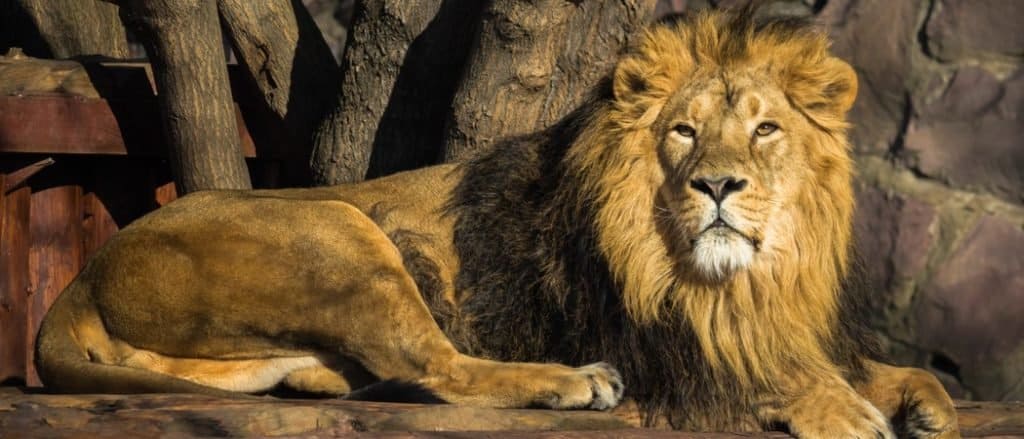
The Asiatic lions living in the Gir Forest are the last of their kind.
©tgladkova/Shutterstock.com
When we think of lions, our minds tend to travel to Africa. But there’s a small population of lions living far from the African savannas: the Asiatic lions in the Gir Forest of India. These lions are the last of their kind in Asia, and they live in a very different environment from their African relatives. The Gir Forest is a mixture of:
- Dry deciduous forest
- Semi-evergreen and evergreen trees
- Scrub jungle
- Grasslands
- Rocky hills
This unique and diverse habitat supports about 500 Asiatic lions.
Lions in Captivity
Lions also live in captivity in zoos and wildlife reserves across the world, including our record-breaking monster at the Dublin Zoo. These big cats experience a very different environment from their wild counterparts. They have steady access to food and healthcare, but their space is limited, and they don’t engage in the behaviors typical of wild lions, like hunting or competing for territory.
What Do Lions Eat?
Alright, folks, it’s time to talk about the lion’s dinner plate. Of course, as apex predators, they have a diverse menu, but what exactly does their diet consist of?
The Carnivorous King
Let’s get straight to the point: lions are carnivores. This means their diet primarily consists of meat. So from the smallest gazelle to the largest buffalo, if it’s made of meat and it’s in the vicinity, it’s potential food for these guys.
Favorite Dishes
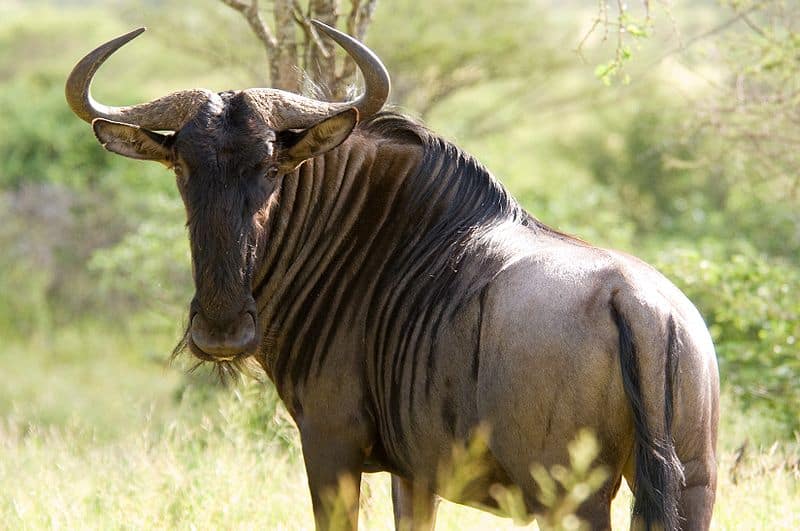
Wildebeest is one of lions’ favorite meals.
©Chris EasonCamera location24° 45′ 57.79″ S, 31° 53′ 31.74″ E View this and other nearby images on: OpenStreetMap-24.766054; 31.892150, CC BY 2.0, via Wikimedia Commons – License
In the African savannas, the lion’s menu often includes wildebeests, zebras, and buffaloes. These herbivores make up the bulk of their diet, providing the high-protein meal they need to maintain their strength. If these are unavailable, they won’t shy away from smaller snacks like rodents, reptiles, or even birds.
Opportunistic Feeders
Lions are opportunistic feeders. This means they’re not picky about what kind of meat they eat or where it comes from. If the opportunity presents itself, lions scavenge and take over kills made by other predators, like hyenas or cheetahs. It’s all fair game in the wild!
Hunting: A Group Effort
Hunting is mostly a team sport for lions. However, they’ve perfected the art of cooperative hunting, where members of a pride work together to bring down prey. Females typically do the majority of the hunting, while males protect their pride and their territory.
The Diet of Our Record-Breaking Lion
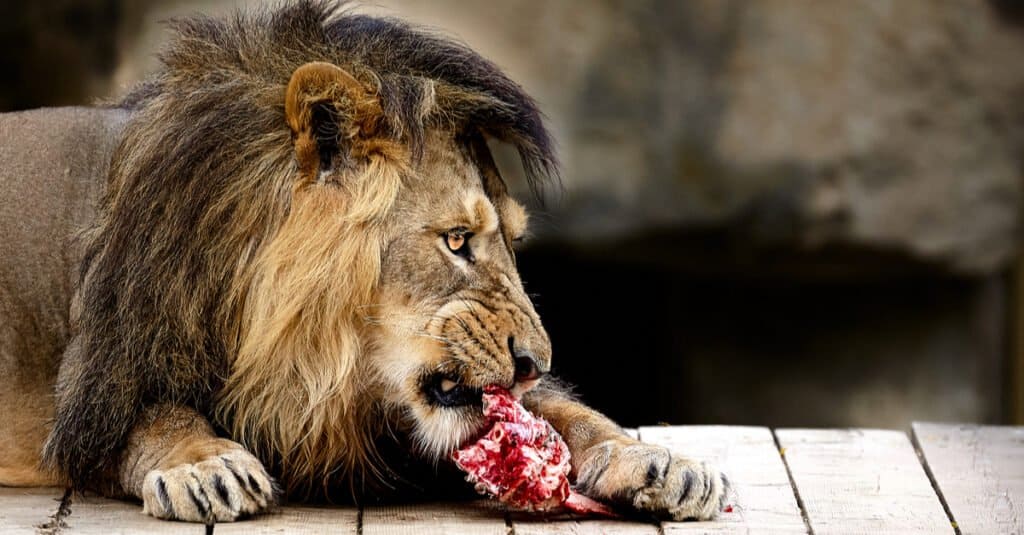
Lions in captivity receive a constant supply of fresh meat to keep them healthy.
©J_K/Shutterstock.com
Now, what about our colossal cat from the Dublin Zoo? Captive lions like him have a diet that their caregivers manage. It typically consists of a balanced supply of meats designed to provide the nutrients they need. So while not having to hunt for their food, these big cats still need a diet that mimics what they would consume in the wild to stay healthy.
Threats to Lions
Let’s turn our attention to a somber topic. Despite their reputation as Kings of the Jungle, lions face numerous threats in today’s world. From habitat loss to conflicts with humans, it’s important we understand these threats to help ensure the survival of these majestic creatures.
Habitat Loss and Fragmentation
At the top of the list is the loss and fragmentation of habitats. As human populations expand and as agriculture, settlements, and roads continue to encroach upon the land, the vast landscapes that lions once freely roamed are vanishing.
This loss and fragmentation of habitat not only reduce the space these big cats have to live and hunt but also impacts the populations of their prey.
Human-Lion Conflict
Next, we have the human-lion conflict. As lions’ habitats shrink, encounters between humans and lions increase. These encounters can be deadly, especially when they attack livestock, and in retaliation, they are often killed.
Poaching and Trophy Hunting
Sadly, illegal hunting and poaching also pose a major threat to lions. They’re killed for their body parts, which are used in traditional medicine and as status symbols. Trophy hunting, the practice of killing wild animals for sport, can also contribute to the decline in populations. While it’s sometimes argued that trophy hunting can provide funds for conservation, it’s a controversial subject with a significant impact on individual lions and their pride.
Disease and Climate Change

Climate change affects the environment, which in turn affects wildlife populations.
©leolintang/Shutterstock.com
Diseases exacerbated by climate change and inbreeding in small populations also threaten lions. One example is the canine distemper virus, which has caused fatal outbreaks in their populations. Additionally, changes in climate patterns can affect the availability of prey and the lions’ ability to hunt, thus impacting their survival.
Threats to Captive Lions
In contrast, captive lions like our record-breaking one from Dublin Zoo face different challenges. Their threats often revolve around inadequate living conditions, such as:
- Small enclosures
- Insufficient diets
- Lack of veterinary care
It’s crucial that captive environments provide for all the lions’ needs and prioritize their well-being.
Key Takeaways
We’ve taken a deep dive into the realm of the largest lion ever recorded, gaining insight into why it grew to such a massive size. We’ve explored the typical habitats of these big cats, understood their diet, and highlighted the key threats they face in the wild today.
From our enormous friend at Dublin Zoo to other notable giants of the lion world, the magnificence and strength of these beasts have no doubt left an impression. It’s fascinating to realize that unique circumstances like genetics, diet, and even castration can result in such extraordinarily large lions. However, amidst their grandeur, it’s essential to remember the plight of these regal creatures. Lions are confronted with challenges such as habitat loss, human conflict, and disease. By increasing our knowledge and concern for these majestic animals, we can contribute to ensuring their survival in the wild for generations to come.
The photo featured at the top of this post is © keith hudson/Shutterstock.com
Thank you for reading! Have some feedback for us? Contact the AZ Animals editorial team.






